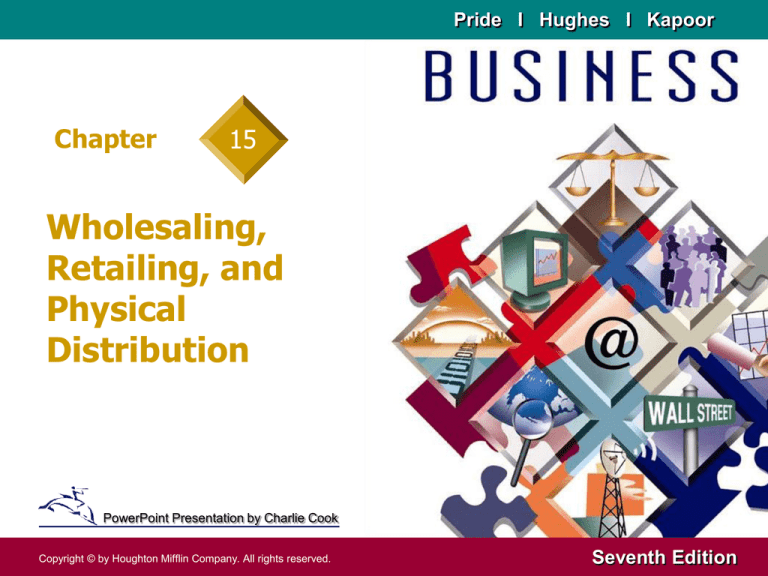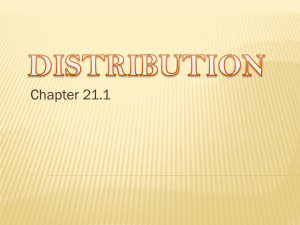
Pride I Hughes I Kapoor
Chapter
15
Wholesaling,
Retailing, and
Physical
Distribution
PowerPoint Presentation by Charlie Cook
Copyright © by Houghton Mifflin Company. All rights reserved.
Seventh Edition
Channels of Distribution
• Channel of distribution (or marketing channel)
– A sequence of marketing organizations that directs a product
from the producer to the ultimate user.
• Middleman (or marketing intermediary)
– A marketing organization that links a producer and user within a
marketing channel.
• Merchant middleman—takes title to products by buying them.
• Functional middleman—helps in the transfer of ownership of
products but does not take title to the products.
• Retailer—buys from producers or other middlemen and sells to
consumers.
• Wholesaler—a middleman that sells products to other firms.
Copyright © by Houghton Mifflin Company. All rights reserved.
15–2
Channels for Consumer Products
• Producer to consumer (direct channel)
– The marketing channel includes no intermediaries.
– The distribution channel used by all services and consumer
goods that are sold directly to the consumer.
• Producer to retailer to consumer
– Producers sell directly to large retailers (e.g., Wal-Mart) and to
others where shipping and handling costs are high, where the
products are perishable, or fashion products that need to reach
the consumer as soon as possible.
• Producer to wholesaler to retailer to consumer
– The traditional channel where the wholesaler services the
numerous retailers for the producer.
Copyright © by Houghton Mifflin Company. All rights reserved.
15–3
Channels for Consumer Products
• Producer to agent to wholesaler to retailer to
consumer
– Agents market producer products to wholesalers on a
commission basis.
• Multiple channels for consumer products
– Manufacturers use different channels to reach different market
segments.
• Channels for business products
– Producer to business user—a direct channel in which the
manufacturer’s own sales force sells directly to the consumer.
– Producer to agent middleman to business user—an independent
intermediary represents the manufacturer to the consumer.
Copyright © by Houghton Mifflin Company. All rights reserved.
15–4
Distribution Channels
CONSUMER PRODUCTS
Producer
Consumer
Producer
Producer
Producer
Agent
Retailer
Consumer
Wholesaler
Retailer
Consumer
Wholesaler
Retailer
Consumer
BUSINESS PRODUCTS
Business
customer
Producer
Producer
Agent
middleman
Business
customer
Figure 15.1
Copyright © by Houghton Mifflin Company. All rights reserved.
15–5
Partnering Through Supply Chain Management
• Supply chain management
– A long-term partnership among channel members working to
create a distribution system that reduces inefficiencies, costs, and
redundancies while creating competitive advantage and
satisfying customers.
– The use of bar code data, electronic data interchange, and online
business-to-business selling has increased productivity by
reducing inventory, shortening cycle time, and removing wasted
human effort.
Copyright © by Houghton Mifflin Company. All rights reserved.
15–6
Marketing Intermediaries: Wholesalers
• Types of wholesalers
– Merchant wholesalers—middlemen that purchase goods in large
quantities and then sell them to other wholesalers or retailers
and to institutional, farm, government, professional, or industrial
users.
• Full-service wholesalers (general merchandise wholesaler, limitedline wholesaler, specialty-line wholesaler) and limited-service
wholesalers
– Commission merchants, agents, and brokers—functional
middlemen that do not take title to products and who are paid a
commission for their marketing
activities.
– Manufacturers’ sales branches and
sales offices—Merchant wholesalers
and sales agents owned and
controlled by the manufacturers.
Copyright © by Houghton Mifflin Company. All rights reserved.
15–7
Efficiency Provided by an Intermediary
• The services of an intermediary reduce the number of
contacts, or exchanges, between producers and buyers,
thereby increasing efficiency.
Producer
Buyer
Producer
Buyer
Producer
Buyer
Producer
Buyer
Middleman or
intermediary
Producer
Buyer
Producer
Buyer
Producer
Buyer
Producer
Buyer
Source: William M. Pride and O. C. Ferrell, Marketing: Concepts and Strategies, 2000e.
Copyright © 2000 by Houghton Mifflin Company, Adapted with permission.
Copyright © by Houghton Mifflin Company. All rights reserved.
Figure 15.3
15–8
Marketing Intermediaries: Wholesalers
• Justifications for marketing intermediaries
– Intermediaries perform essential marketing services.
– Manufacturers would be burdened with additional record
keeping and maintaining contact with numerous retailers.
– Costs for distribution would not decrease, and could possibly
increase due to the marketing inefficiencies of producers.
• Wholesalers’ services to retailers
– Promotion—wholesalers promote products to retailers.
– Market information—wholesalers are a two-way source of market
information for both producers and retailers.
– Financial aid—wholesalers provide timely product deliveries that
reduce inventory costs for retailers and extend credit to retailers
for inventory purchases.
Copyright © by Houghton Mifflin Company. All rights reserved.
15–9
Marketing Intermediaries: Wholesalers
• Wholesalers’ services to manufacturers
– Providing instant, ready-made sales forces to manufacturers.
– Reducing manufacturers’ inventory costs by purchasing finished
goods in sizable quantities.
– Assuming the credit risks associated with selling to retailers.
– Furnishing market information gleaned from the market and
customers to the manufacturers.
Copyright © by Houghton Mifflin Company. All rights reserved.
15–10
Market Coverage
• Intensity of market coverage
– Intensive distribution—the use of all available outlets for a
product to saturate the market.
– Selective distribution—the use of only a portion of the available
outlets for a product in each geographic area.
– Exclusive distribution—the use of only a single retail outlet for a
product in a larger geographic area.
Copyright © by Houghton Mifflin Company. All rights reserved.
15–11
Market Coverage
Main Avenue
Willow Street
Ashley Street
Washington Blvd.
Jerry Street
The number of
outlets a producer
chooses for a
product depends
on the type of
product. Batteries,
for example, are
distributed
intensively in this
area; sports
equipment is
selectively
distributed, and
Stubenglass is
exclusively
distributed.
Pearl Street
Intensive
distribution
Selective
distribution
Copyright © by Houghton Mifflin Company. All rights reserved.
Exclusive
distribution
Figure 15.2
15–12
Marketing Intermediaries: Retailers
• Classes of in-store retailers
– Independent retailer—a firm that operates only one retail outlet.
– Chain retailer—a company that operates more than one retail
outlet.
– Department store—a retail store that (1) employs twenty-five or
more persons and (2) sells at least home furnishing, appliances,
family apparel, and household linens and dry goods, each in a
different part of the store.
– Discount store—a self-service, general
merchandise outlet that sells goods at
lower-than-usual prices.
Copyright © by Houghton Mifflin Company. All rights reserved.
15–13
Marketing Intermediaries: Retailers (cont’d)
• Classes of in-store retailers (cont’d)
– Catalog showroom—a retail outlet that displays well-known
brands and sells them at discount prices through catalogs within
the store.
– Warehouse showroom—a retail facility in a large, low-cost
building with large on-premises inventories and minimal service.
Copyright © by Houghton Mifflin Company. All rights reserved.
15–14
Physical Distribution (cont’d)
• Warehousing
– The set of activities involved in receiving and storing goods and
preparing them for reshipment.
– Warehousing activities:
•
•
•
•
•
•
•
Receiving goods from producers.
Identifying and verifying goods received.
Sorting goods for storage.
Dispatching goods to storage.
Holding goods in storage.
Recalling, picking, and assembling goods for shipment.
Dispatching shipped goods.
– Types of warehouses:
• Private warehouses are owned by a firm to serve its needs.
• Public warehouses offer storage space to all firms.
Copyright © by Houghton Mifflin Company. All rights reserved.
15–15
Marketing Intermediaries: Retailers (cont’d)
• Classes of in-store retailers (cont’d)
– Convenience store—a small food store that sells a limited variety
of products but remains open well beyond normal business
hours.
– Supermarket—A large self-service store that sells primarily food
and household products.
– Superstore—A large retail store that carries not only food and
nonfood products ordinarily found in supermarkets but also additional product lines.
– Warehouse club—A large-scale, members-only
establishment that combines features
of cash-and-carry wholesaling
with discount retailing.
Copyright © by Houghton Mifflin Company. All rights reserved.
15–16
Marketing Intermediaries: Retailers (cont’d)
• Classes of in-store retailers (cont’d)
– Traditional specialty store—a store that carries a narrow product
with deep product lines.
– Off-price retailer—a store that buys manufacturers’ seconds,
overruns, returns, and off-season merchandise for resale to
consumers at deep discounts.
– Category killer—a very large specialty store
that concentrates on a single product
line and competes on the basis of
price and product availability.
Copyright © by Houghton Mifflin Company. All rights reserved.
15–17
Kinds of Nonstore Retailing
• Nonstore retailing
– A type of retailing whereby consumers purchase products
without visiting a store.
– Direct selling—the marketing of products to ultimate consumers
through face-to-face sales presentations at home or in the
workplace.
– Direct marketing—using computers, telephones, and nonpersonal
media to show products to customers, who can then purchase
them by mail, telephone, or online.
– Catalog marketing—marketing in which an organization
provides a catalog from which customers make selections and
place orders by mail or telephone.
– Direct response marketing—marketing that occurs when a
retailer advertises a product and makes it available through mail
or telephone orders.
Copyright © by Houghton Mifflin Company. All rights reserved.
15–18
Kinds of Nonstore Retailing (cont’d)
• Nonstore retailing (cont’d)
– Telemarketing—the performance of marketing-related activities
by telephone.
– Television home shopping—selling in
which products are displayed to home
viewers, who can then order the products
by calling a toll-free number and paying
by credit card.
– Online retailing—presenting and
selling products through
computer connections.
– Automatic vending—the use of
machines to dispense products.
Copyright © by Houghton Mifflin Company. All rights reserved.
15–19


